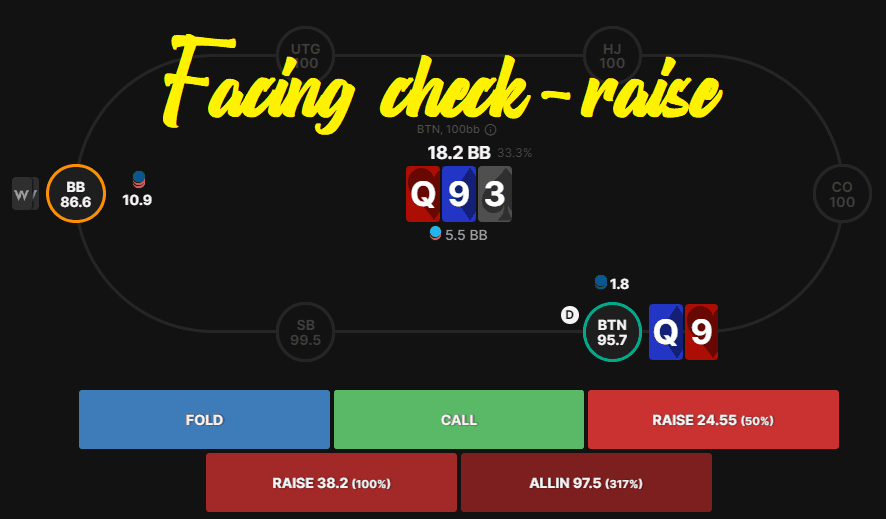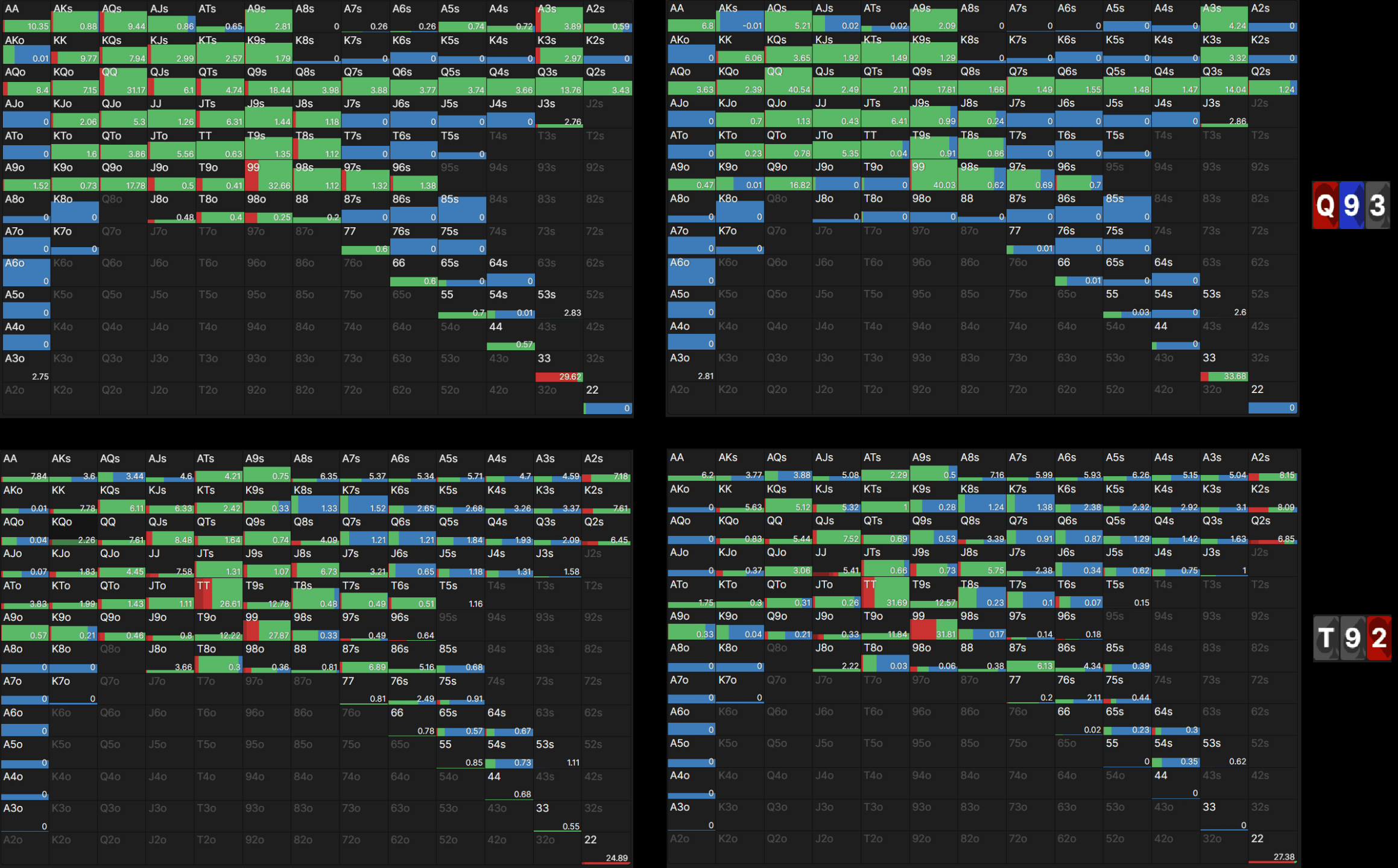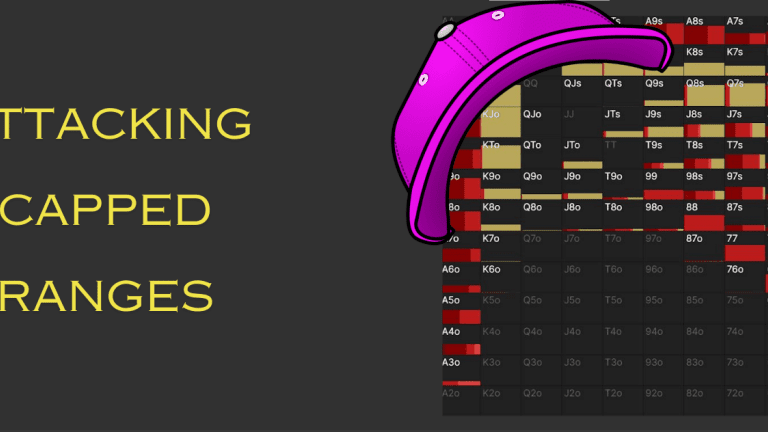In this previous article, we have already discussed how to check-raise efficiently. Now, we'll examine how theory works and then how to deviate against different opponents. To start, here you can find what we've established about our c-betting strategy.

Theory of check-raise in poker
If you look up solver strategies, you'll notice that the optimal check-raising frequencies are almost always higher than what real players execute at the tables. Various elements define the frequencies and specific hands that a solver would choose to check-raise. One of the driving factors is range interaction with the given board. The more strong hands the defender has, the wider she can go with bluffs as well. Nevertheless, the in-position player's strategy can "provoke" more raises simply by c-betting a wide range with a small sizing. Another factor in the check-raise range construction is board coverage (so each runout gives nutted hands, a board paring card or a draw-completing card, etc., all should be at least okay to your perceived range).
So, what are the consequences when we are on the other side? What hands are strong enough to continue, and what type of hands should you give up? A lot depends on the flop texture, but we can make a few rules of thumb.
On a dry board, basically, any pair could continue (except such pocket pairs that are underpairs and have deficient drawing characteristics), and most of the draws, even hands like two overcards with a backdoor flush draw, have incentives to call at least one street.
Consider folding more of the pairs, even top pairs, which block hands from the bluffing range on a more connected board. There is no one-fit-all answer here because factors like the raise size and the specific board might change the correct hands to continue with.

Examples on how to continue on Q93r and T92tt from a solver, against various check-raise sizes respectively.
Blue – fold, green – call, red – 3-bet
If all defending strategies are complicated and dependent on various factors, then you might ask how we benefit from this knowledge. It would help if you had a framework to work with because your opponents will definitely not play GTO. How do you know how much to deviate and what ways if you don't know from what you need to alter your strategy?
Play against the average online poker players
First and foremost, the average regular player is folding way too much and not check-raising enough on the flop as the preflop caller. That's why small-sized c-bets with a high frequency overperform in many of these spots.
What else does check-raising imply? These ranges not only lack thin check-raises, such as a top pair with a top kicker, but also miss most of the bluffs. So, the average regular with her 7-12 per cent check-raise will find the strongest value and add some of the strongest bluffs, such as combo draws and pair+draws, while in theory, they should raise around 15-25% in some cases with a bunch of backdoor draws, low pairs, etc.
The correct response is to attack them with a wide range on the flop by betting for a small sizing and folding more often when they start to put a lot of money into the pot. Hands that would typically continue in equilibrium, such as any pair, weak draws like gutshots, etc., now become pure folds. To continue, you must block your opponent's value hands and unblock their bluffs.
Another consequence you might want to consider is fastplay your superstrong hands like a set on a dynamic board. When you assume that Villain's range is more robust than it should be and you have a hand that beats some or most of her value region, you are more incentivized to pile the money in. The runout can spoil your value or discourage your opponent from stacking off with an excellent but weaker hand than yours.
Play against aggressive online poker regulars
The strategy becomes more complicated against aggressive regulars. Their frequencies will be closer to GTO, and sometimes even overbluffing some favorable spots. If you noticed, we haven't talked about good or bad players but aggressive ones. That one factor can make your life hell if you attack them the same way as the average player.
Your counterstrategy should be a more theoretical approach. In general, you want to c-bet less often and probably use a polarized range and sizing, aka betting bigger with solid hands and good bluffs. You'll need to protect your checking ranges, but this comes hand in hand. So you'll need to add hands to your checking range, like top pairs with a weak kicker or a strong draw capable of continuing on any turn card, like a flush draw with two overcards (AKs is a great example).
Also, you could induce bluffs with solid hands by sizing down (even if the board requires a different c-bet sizing). You'll need to be very careful and understand how dynamic changes with possible outcomes.
Another great thing to introduce is the 3-bet bluff on the flop, which is a bit advanced but works very well when applied correctly. Let's say Villain check-raises you on a Kh5d2c board in a BTNvBB spot. It's a pretty dry flop, but aggressive players will find enough bluffs here, especially against a perceived rangebet. Villain's value is centred around sets (22, 55) and two pairs (K5s, K2s), which determine that they cannot go too crazy with bluffs. Still, there are the most obvious for open-ended straight draws (43s) and gutshots (64s, 63s, A4s, A3s, A4o). All this alone is enough to overbluff the spot if Villain opts to raise all of them, and we haven't mentioned hands like backdoor draws or a pair with backdoors. Therefore, you can put a lot of pressure on this low end of their range by 3-bet bluffing them. In terms of what hands to use here? Anything that doesn't block their bluffs could be a good idea. If it blocks value, that might be a good choice as well. You must evaluate if calling has a higher EV than raising it there. So, you might pick QsJs, which block some of Villain's thin value (KQ or KJ) but don't block any bluffs, not even backdoor hands.
Play against recreationals online poker players
Probably the most fun to play in this spot is against recreational players. There is always a certain random factor in their play; you'll never know if a small c-bet size induced them or if they just decided to outplay you for no specific reason on that hand.
First, you should determine what type of player you play against. If she is passive (confirmed by data), you might assume that a check-raise range is stronger than it should be. In that case, you should follow a somewhat similar strategy as we discussed against the average regulars. If something, you should fold even more.
There is the other extreme, the aggressive type. You can expect even more aggression and bluffs than in the case discussed above against aggressive regs. As a matter of fact, bluffs by regulars usually are centred around some kind of equity (even if it's low, in the form of backdoors). On the contrary, recreationals build this check-raise artificially based on the belief that you are weak and they can get an immediate fold. So, if anything, you must buckle up and float (even call down) lightly against them.
Besides the extreme and well-known categories, there are the in-between and the unknown players. It would be best if you approach them with caution but, at the same time, expect that they overbluff most spots. Mass data analysis points out that recreational players tend to overbluff every spot. Does that mean your opponent will 100% bluff in the given hand? No, of course not. It means that the fact she is not a regular increases the chance that she will overbluff, even in a spot like flop check-raising.
Therefore, try to get to a showdown with any decent hand (even ace-high, king-high if they make sense). You can conclude how your opponent approaches the spot even from one showdown. If she shows up with any merge hand, like a third pair or a hand with zero connectivity to the board, you can conclude she is overbluffing, and you have to call down each time with a wide range.
Just to clarify, you shouldn't call down for stacks to any unknown player. Evaluate your situation, float a check-raise wide, and see what comes next. Pay attention at the table; showdowns are valuable even when you are not involved in a hand.
Summary
To summarize, the most important when facing a check-raise is who your opponent is. What player type and how wide of a range can you perceive? Your response might be overfolding or bluff-raising, changing your c-bet strategy, or simply following a more theoretical approach. Either way, you should constantly adapt to your opponent! Avoid playing an autopilot, one-fit-all strategy.
Good luck at exploiting your opponents when you face a check-raise!





















